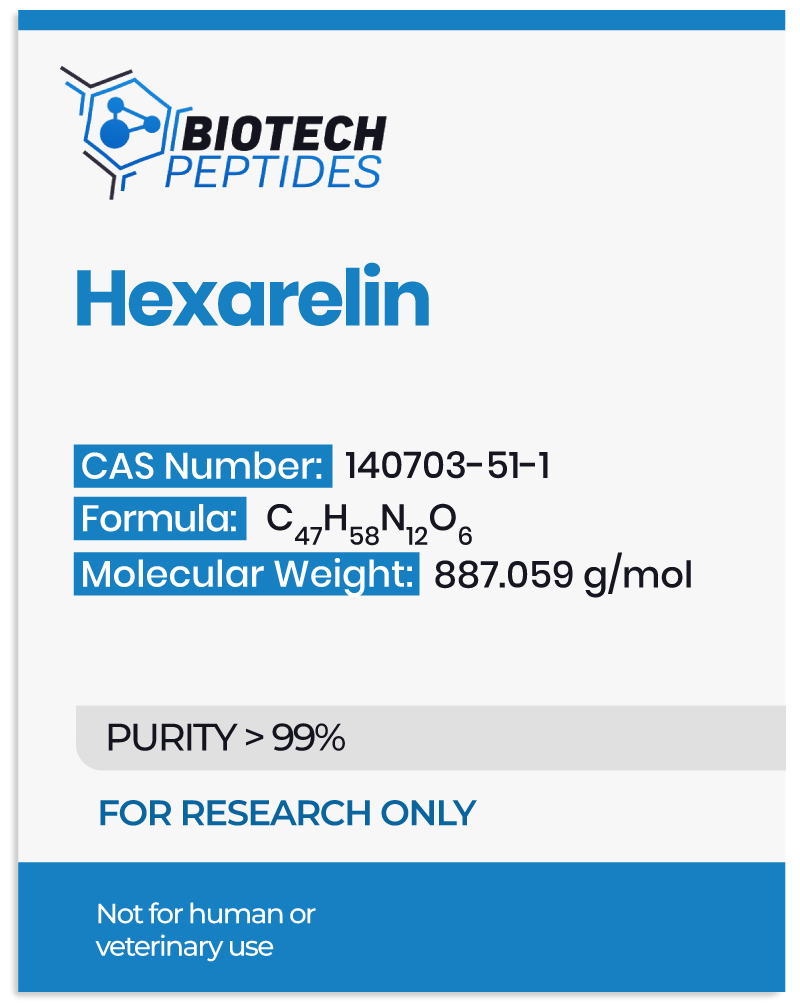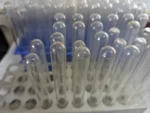Hexarelin studies suggest its high selectivity for the ghrelin receptor, also known as the growth hormone secretagogue receptor 1a (GHSR1a). It appears to exhibit potent activity in stimulating growth hormone release, causing researchers to classify it as a growth hormone secretagogue. Its ability to selectively activate the GHSR1a sets it apart from other compounds in this class. Furthermore, Hexarelin is a unique peptide that appears to be resistant to degradation by digestive enzymes. Yet, the precise mechanisms of action and the full range of Hexarelin’s potential are not definitively established, and its specific interactions with growth hormone secretagogue receptors are still the subject of ongoing research.
Hexarelin Peptide and the Central Nervous System
Hexarelin, a peptide compound, appears to interact with the GHSR1a in the central nervous system, potentially initiating a cascade of intracellular signaling events that modulate various physiological processes. This interaction is hypothesized to occur due to the high affinity and specificity between Hexarelin and the binding site of GHSR1a receptors.
Research studies suggest that as Hexarelin binds to GHSR1a receptors, it may activate intracellular signaling pathways. These pathways are considered to involve molecular events, including the activation of G-proteins like Gαq/11, leading to the activation of phospholipase C (PLC). PLC induces the hydrolysis of phosphatidylinositol 4,5-bisphosphate (PIP2) into inositol triphosphate (IP3) and diacylglycerol (DAG). IP3 release may initiate the mobilization of intracellular calcium stores, potentially increasing cytosolic calcium levels.[1] [2] This rise in calcium concentration may regulate cellular processes such as neurotransmitter release, gene expression, and intracellular signaling cascades. Additionally, DAG may activate protein kinase C (PKC), phosphorylating target proteins and potentially regulating cellular functions.
Activation of GHSR1a receptors by Hexarelin may lead to the release of specific hormonal substances from the pituitary gland. These potential substances include growth hormone (GH), prolactin, adrenocorticotropic hormone (ACTH), and cortisol.[3] [4] Furthermore, the interaction between Hexarelin and GHSR1a receptors in the hippocampus potentially impacts neuronal function and communication. Its specific impact on cellular processes in the hippocampus is not fully understood but is suggested to play a role in the modulation of synaptic plasticity, neurotransmitter release, and mechanisms involved in memory consolidation and cognitive processes.
Furthermore, one study investigated the protective potential of Hexarelin peptide on the central nervous system, particularly the hippocampus. The study used a rat model of neonatal hypoxia-ischemia induced by carotid ligation and hypoxic exposure.[5] The researchers commented that “damage was reduced by 39% in the treatment group, compared with the vehicle group, and injury was significantly reduced in the cerebral cortex, hippocampus, and thalamus but not in the striatum.” Moreover, the study reported that reduction in brain damage appeared to coincide with a decrease in caspase-3 activity, an enzyme involved in cell death, and an increase in the phosphorylation of Akt and glycogen synthase kinase-3beta. Overall, the activation of the Akt signaling pathway appeared to play a role in reducing cell death by modulating glycogen synthase kinase-3beta activity and possibly inhibiting caspase-dependent cell death.
Hexarelin Peptide and the Ghrelin (GHSR1a) Receptors
Hexarelin peptide has complex potential interactions with the ghrelin receptors in the pituitary gland and the hypothalamus. Moreover, these interactions may be modified by other hormonal substances. For example, certain androgens may have the potential to upregulate ghrelin receptors, which could potentially enhance the response of these receptors to Hexarelin.[6] It is hypothesized that androgens might modulate the expression or sensitivity of ghrelin receptors at the cellular level, although the precise mechanisms behind this interaction are not fully understood. It is possible that androgens could alter gene expression or intracellular signaling pathways, increasing the expression or sensitivity of ghrelin receptors. If this modulation occurs, it is speculated that Hexarelin may have a greater binding affinity to these upregulated receptors, potentially resulting in an amplified Hexarelin action and an apparent release of growth hormone.[7]
Another factor that may potentially enhance the interaction between Hexarelin and the GHSR1a is the simultaneous activation of another receptor found on the pituitary gland, the growth hormone-releasing hormone (GHRH) receptor. For example, researchers have simultaneously tested Hexarelin (HEX) and the natural GHRH-receptor activator – GHRH.[8] They commented that “the two substances induced a true synergistic effect, with GH release after HEX plus GHRH (…) being higher (…) than the arithmetic sum of the GH increases induced by each compound separately.” Other studies have also commented on similar findings.[9] [10] This apparent synergism may be due to two potential mechanisms. Firstly, Hexarelin may potentially sensitize somatotroph cells in the pituitary gland, making them more responsive to the stimulatory action of GHRH. This increased sensitivity may lead to a higher potential for GH release when Hexarelin and GHRH are used together compared to using either compound alone. Secondly, both Hexarelin and GHRH may inhibit the release of somatostatin, a hormone that is considered to suppress GH secretion. By acting together, Hexarelin and GHRH may express a higher potential for somatostatin suppression, allowing for increased GH secretion.
Conclusion
In conclusion, Hexarelin peptide may have potential interactions with the ghrelin receptor (GHSR1a) in the central nervous system. Its proposed resistance to degradation by digestive enzymes further distinguishes it from other compounds in its class. It may modulate intracellular signaling pathways and stimulate growth hormone release from pituitary cells. Furthermore, it may affect the release of specific hormonal substances and appears to play a role in synaptic plasticity, memory consolidation, and cognitive processes. Hexarelin’s interactions with other hormonal substances, such as androgens and growth hormone-releasing hormone (GHRH), may influence its action.
Disclaimer: The products mentioned are not intended for human or animal consumption. Research chemicals are intended solely for laboratory experimentation and/or in-vitro testing. Bodily introduction of any sort is strictly prohibited by law. All purchases are limited to licensed researchers and/or qualified professionals. All information shared in this article is for educational purposes only.
References
- Khatib, N., Gaidhane, S., Gaidhane, A. M., Khatib, M., Simkhada, P., Gode, D., & Zahiruddin, Q. S. (2014). Ghrelin: ghrelin as a regulatory Peptide in growth hormone secretion. Journal of clinical and diagnostic research : JCDR, 8(8), MC13–MC17. https://doi.org/10.7860/JCDR/2014/9863.4767
- Yin, Y., Li, Y., & Zhang, W. (2014). The growth hormone secretagogue receptor: its intracellular signaling and regulation. International journal of molecular sciences, 15(3), 4837–4855. https://doi.org/10.3390/ijms15034837
- Frieboes, R. M., Antonijevic, I. A., Held, K., Murck, H., Pollmächer, T., Uhr, M., & Steiger, A. (2004). Hexarelin decreases slow-wave sleep and stimulates the secretion of GH, ACTH, cortisol and prolactin during sleep in healthy volunteers. Psychoneuroendocrinology, 29(7), 851–860. https://doi.org/10.1016/S0306-4530(03)00152-5
- Imbimbo, B. P., Mant, T., Edwards, M., Amin, D., Dalton, N., Boutignon, F., Lenaerts, V., Wüthrich, P., & Deghenghi, R. (1994). Growth hormone-releasing activity of hexarelin in humans. A dose-response study. European journal of clinical pharmacology, 46(5), 421–425. https://doi.org/10.1007/BF00191904
- Brywe, K. G., Leverin, A. L., Gustavsson, M., Mallard, C., Granata, R., Destefanis, S., Volante, M., Hagberg, H., Ghigo, E., & Isgaard, J. (2005). Growth hormone-releasing peptide hexarelin reduces neonatal brain injury and alters Akt/glycogen synthase kinase-3beta phosphorylation. Endocrinology, 146(11), 4665–4672. https://doi.org/10.1210/en.2005-0389
- Loche, S., Cambiaso, P., Carta, D., Setzu, S., Imbimbo, B. P., Borrelli, P., Pintor, C., & Cappa, M. (1995). The growth hormone-releasing activity of hexarelin, a new synthetic hexapeptide, in short normal and obese children and in hypopituitary subjects. The Journal of clinical endocrinology and metabolism, 80(2), 674–678. https://doi.org/10.1210/jcem.80.2.7852535
- Loche, S., Colao, A., Cappa, M., Bellone, J., Aimaretti, G., Farello, G., Faedda, A., Lombardi, G., Deghenghi, R., & Ghigo, E. (1997). The growth hormone response to hexarelin in children: reproducibility and effect of sex steroids. The Journal of clinical endocrinology and metabolism, 82(3), 861–864. https://doi.org/10.1210/jcem.82.3.3795
- Arvat, E., Di Vito, L., Gianotti, L., Ramunni, J., Boghen, M. F., Deghenghi, R., Camanni, F., & Ghigo, E. (1997). Mechanisms underlying the negative growth hormone (GH) autofeedback on the GH-releasing effect of hexarelin in man. Metabolism: clinical and experimental, 46(1), 83–88. https://doi.org/10.1016/s0026-0495(97)90173-6
- Massoud, A. F., Hindmarsh, P. C., & Brook, C. G. (1996). Hexarelin-induced growth hormone, cortisol, and prolactin release: a dose-response study. The Journal of clinical endocrinology and metabolism, 81(12), 4338–4341. https://doi.org/10.1210/jcem.81.12.8954038
- Arvat, E., Gianotti, L., Di Vito, L., Imbimbo, B. P., Lenaerts, V., Deghenghi, R., Camanni, F., & Ghigo, E. (1995). Modulation of growth hormone-releasing activity of hexarelin in man. Neuroendocrinology, 61(1), 51–56. https://doi.org/10.1159/000126827







